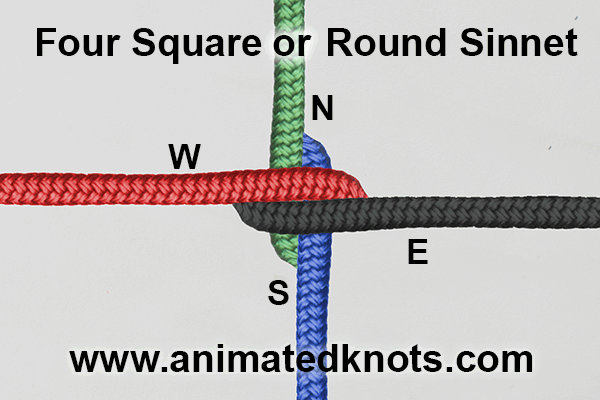A decorative solid braid that can also be used for hair.
Four Strand Square Sinnet
A decorative solid braid that can also be used for hair.
 |  |

 |  |  |  |  |
To Step use Arrow Keys (
Description: Ashley (ABOK) describes this Sinnet as both a Four Strand Square Sinnet (# 2999, p 493, and # 3017, p 496) and as a Round Twist Sinnet (# 3952, p485). He describes how to shape the Sinnet: “Roll this sinnet underfoot and it will be round; pound it thoroughly with a mallet, first one side, then the next adjacent side, and it will be square.” These methods probably work well on tarred hemp; they will have little effect on modern synthetic rope.
Comparison: Six Simple Sinnets are shown here to illustrate that even e few strands allow considerable variety and Ashley actually shows a couple more which are not symmetrical. The Simple Braid (1) and the Simple Braid (2) are identical except they are viewed from opposite sides; moreover, tying each version feels quite different. The French Sinnet (1) and French Sinnet (2) are also essentially the same but the way they are tightened makes them look very different. The Square (or Round) Sinnet is pleasingly solid in contrast to #2974 which is more decorative and far more open.
Uses: Four Strand Square Sinnet is one of the patterns used to braid hair. It also converts lengths of string or colored plastic into pleasingly solid bands. If you are old enough you may remember that it was once widely used to connect a telephone handset to its base unit. Sinnet is also spelled Sennet, Sennit, and Synet.
Technique: Making the Four Strand Square Sinnet is better visualized from above the sinnet as it is being formed: the radial symmetry is much more obvious. The formed Sinnet is held in one hand with the four strands at the top; the other hand is used to tie the Sinnet. One pair of strands rotates clockwise and the other rotates counter-clockwise. If the North strand always descends on the East, then East strand always crosses to the North.
Starting the Sinnet: For this demonstration, four colors, and therefore four cords, were used. A Four Strand Square Sinnet is often started using only two pieces of cord that cross each other at their centers – a simple way of making one end of the sinnet secure and neat. Ashley also describes using a single strand (# 2952, p 485): two of the four strands are now a loop. However, the process twists this loop and makes a neat result harder to achieve.
Finishing the Sinnet: The other end is completed by tying the cords to a ring or by securing the ends either by melting them or by Whipping them.






